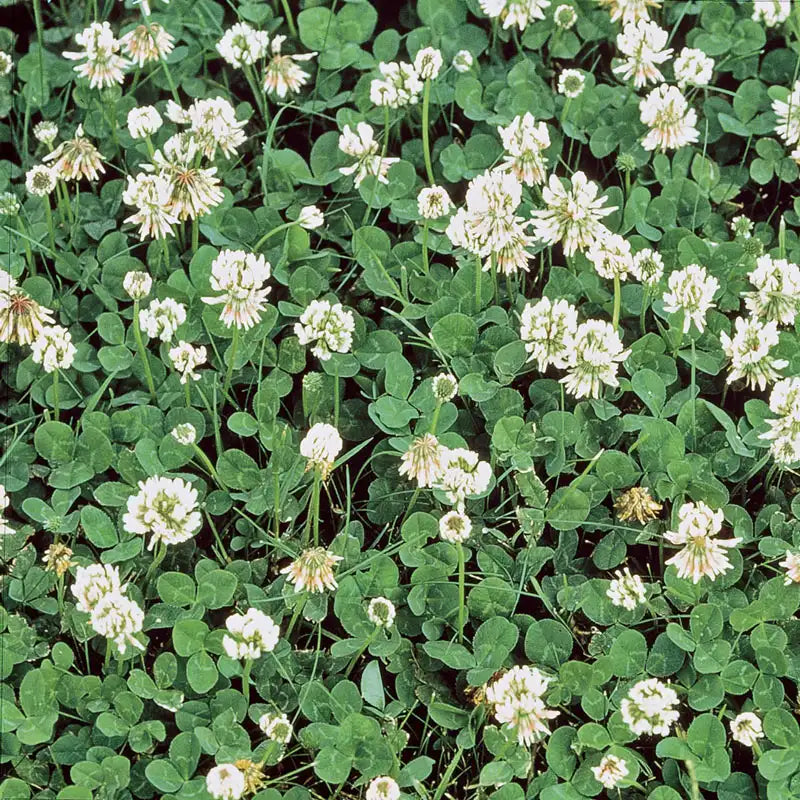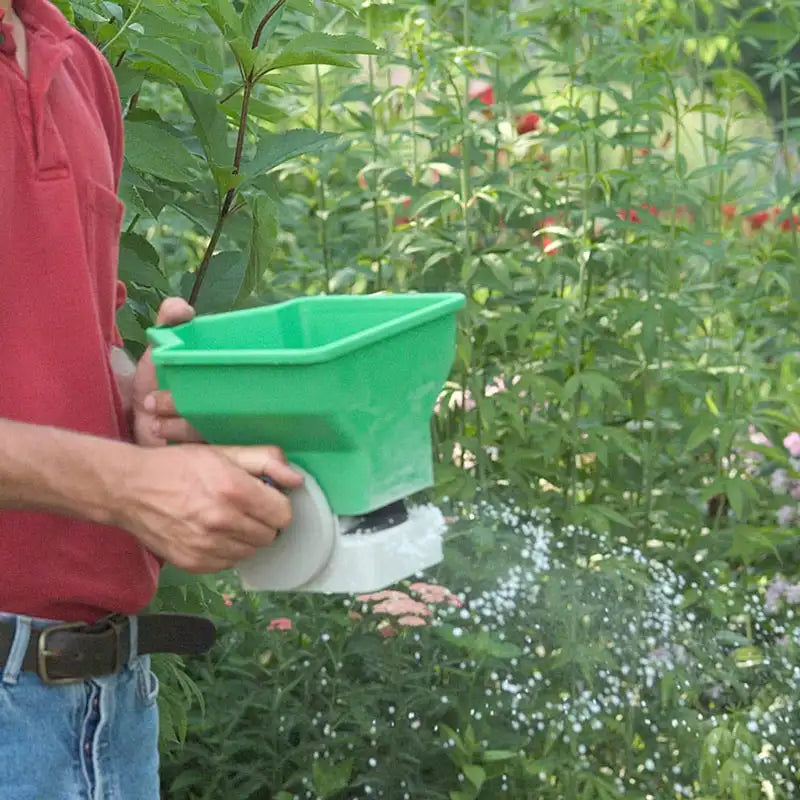We'll Have you Rolling in the Clover!
Q. I like your idea of using corn gluten meal in the fall to prevent lawn weeds, but I don't want to get rid of the clover in my lawn--in fact, I'd like to have more of it. Should I Not use corn gluten meal?
---Al in Mt. Airy
A. The short answer is that clover grows best in poor soil; so to help it compete with your grass, you would not directly fertilize your turf. Instead, use a mulching mower; the pulverized, nitrogen-rich grass clippings (and in your case, the even more nitrogen-rich clover clippings) these specialized mowing machines return to the turf will give your lawn--including the clover--a gentle feeding every time you mow. (Conversely, if you want to decrease the amount of clover in a cool-season lawn, you would feed it with corn gluten meal in the Fall and in the Spring.)
Q. I know most people want to kill the clover in their lawns, but I want the opposite--to lose the grass and get the clover to take over. Do you have any advice on creating a clover lawn?
---Mark in Philadelphia
Are there any down sides to having a "lawn" of clover?
---Martin in Wilmington, DE
We're trying to establish Dutch White clover as a lawn. It's taking a while (and summer wasn't the smartest time to plant, but keeping the soil moist has helped a lot). The problem is that it's getting overrun with weeds, which we diligently pull; but I'd have to quit my job to really keep things under control! The sassy guy in the garden center at Lowes said that tilling just makes weed problems worse, and that any pre-emergent weed killer will "salt the earth" and prevent us from growing anything for a year or more. He was right about the tilling, but we need a way to kill the weeds before they sprout that will still allow our clover to grow from seed.
----Misha in Rancho Cucamonga, CA
A. Let's begin with a clear look at the plant in question. There are three true members of the clover family: White (sometimes called 'Dutch clover'), Red, and Crimson (yes, Tommy James & The Shondells fans, there really is a Crimson Clover).
Alas, Crimson clover would not make a good lawn; it's an annual plant that dies at the first frost. But it's a dramatic one-season plant, growing up to three feet tall with beautifully colored blooms that attract lots of pollinators and beneficial insects. It's used by farmers--and savvy gardeners--as a green manure/cover crop. Its deep roots naturally aerate the soil, and after it dies, the above ground growth is either plowed under to nourish the following year's crop or just mowed and left on the ground to release its nutrients slowly without any tilling.
Red clover is biennial--a plant that lives for two seasons. It also grows tall--two to three feet high--grows fast, loves cold, hates heat, does not attract pollinators and grows in the worst soils. It's used almost exclusively as a soil- and drainage-improving cover crop.
White clover is the best choice for seeding a lawn. (In fact, white clover was a deliberate component of virtually all grass seed mixtures up until the 1960's.) It stays fairly low (topping out at around a foot), can be mowed just like a lawn, handles foot traffic better than the other clovers and tolerates summer heat better. But, like cool-season grasses themselves, white clover still doesn't like hot summers, and may need a lot of water to survive them. (Typically, clover needs more water than lawn grasses.) It's also slow to establish; and although 'technically' perennial, isn't very long lived. That means--like the shade-tolerant cool-season lawn grasses--it should be overseeded or freshly seeded every couple of years in the fall. The flowers do attract and feed bees, so don't go barefoot on it.
Because white clover does behave so much like a cool-season grass, I suspect it would do also best when the seed is sown in late summer--when the heat is abating but the soil is still warm. (As with the cool-season grasses, Spring sowings require you to wait until the soil temp is at least 60 degrees; and by then, stressful summer heat is generally right around the corner.)
To help clover be a lawn rather than just be a part of one, you should add as little direct nutrition to the soil as possible. Clovers have the ability to form a symbiotic relationship with soil-dwelling bacteria that enables the plants to take nitrogen out of the air, and so they kind of feed themselves. (To make sure that this 'nitrogen fixation' takes place, purchase a clover-specific inoculant and use it at planting time.)
To start out relatively weed-free (with a big tip of the YBYG hat to the guy at Lowe's who bad-mouthed chemical herbicides; he's my new hero!), make a 'stale seed bed'. Till the area about a month before planting time (which is ideally mid-August for both white clover and the cool-season lawn grasses), rake away as much of the old green as possible, level the soil, water daily to encourage all of the weeds seeds you uncovered and then planted to sprout, and then slice off the resulting weeds with a sharp hoe two weeks later.
You should then be able to sow your inoculated clover seed, cover it with weed-seed-free topsoil and have a good start on a clover-ishous lawn!
Oh, and one final note--chemical herbicides do 'salt the soil' and make it difficult for any plant to thrive, but the natural pre-emergent herbicide corn gluten meal actually improves the soil, long term. You just have to remember that, being a pre-emergent, it does prevent all seeds from sprouting for about six weeks after it's applied--but that's its job!
---Al in Mt. Airy
A. The short answer is that clover grows best in poor soil; so to help it compete with your grass, you would not directly fertilize your turf. Instead, use a mulching mower; the pulverized, nitrogen-rich grass clippings (and in your case, the even more nitrogen-rich clover clippings) these specialized mowing machines return to the turf will give your lawn--including the clover--a gentle feeding every time you mow. (Conversely, if you want to decrease the amount of clover in a cool-season lawn, you would feed it with corn gluten meal in the Fall and in the Spring.)
Q. I know most people want to kill the clover in their lawns, but I want the opposite--to lose the grass and get the clover to take over. Do you have any advice on creating a clover lawn?
---Mark in Philadelphia
Are there any down sides to having a "lawn" of clover?
---Martin in Wilmington, DE
We're trying to establish Dutch White clover as a lawn. It's taking a while (and summer wasn't the smartest time to plant, but keeping the soil moist has helped a lot). The problem is that it's getting overrun with weeds, which we diligently pull; but I'd have to quit my job to really keep things under control! The sassy guy in the garden center at Lowes said that tilling just makes weed problems worse, and that any pre-emergent weed killer will "salt the earth" and prevent us from growing anything for a year or more. He was right about the tilling, but we need a way to kill the weeds before they sprout that will still allow our clover to grow from seed.
----Misha in Rancho Cucamonga, CA
A. Let's begin with a clear look at the plant in question. There are three true members of the clover family: White (sometimes called 'Dutch clover'), Red, and Crimson (yes, Tommy James & The Shondells fans, there really is a Crimson Clover).
Alas, Crimson clover would not make a good lawn; it's an annual plant that dies at the first frost. But it's a dramatic one-season plant, growing up to three feet tall with beautifully colored blooms that attract lots of pollinators and beneficial insects. It's used by farmers--and savvy gardeners--as a green manure/cover crop. Its deep roots naturally aerate the soil, and after it dies, the above ground growth is either plowed under to nourish the following year's crop or just mowed and left on the ground to release its nutrients slowly without any tilling.
Red clover is biennial--a plant that lives for two seasons. It also grows tall--two to three feet high--grows fast, loves cold, hates heat, does not attract pollinators and grows in the worst soils. It's used almost exclusively as a soil- and drainage-improving cover crop.
White clover is the best choice for seeding a lawn. (In fact, white clover was a deliberate component of virtually all grass seed mixtures up until the 1960's.) It stays fairly low (topping out at around a foot), can be mowed just like a lawn, handles foot traffic better than the other clovers and tolerates summer heat better. But, like cool-season grasses themselves, white clover still doesn't like hot summers, and may need a lot of water to survive them. (Typically, clover needs more water than lawn grasses.) It's also slow to establish; and although 'technically' perennial, isn't very long lived. That means--like the shade-tolerant cool-season lawn grasses--it should be overseeded or freshly seeded every couple of years in the fall. The flowers do attract and feed bees, so don't go barefoot on it.
Because white clover does behave so much like a cool-season grass, I suspect it would do also best when the seed is sown in late summer--when the heat is abating but the soil is still warm. (As with the cool-season grasses, Spring sowings require you to wait until the soil temp is at least 60 degrees; and by then, stressful summer heat is generally right around the corner.)
To help clover be a lawn rather than just be a part of one, you should add as little direct nutrition to the soil as possible. Clovers have the ability to form a symbiotic relationship with soil-dwelling bacteria that enables the plants to take nitrogen out of the air, and so they kind of feed themselves. (To make sure that this 'nitrogen fixation' takes place, purchase a clover-specific inoculant and use it at planting time.)
To start out relatively weed-free (with a big tip of the YBYG hat to the guy at Lowe's who bad-mouthed chemical herbicides; he's my new hero!), make a 'stale seed bed'. Till the area about a month before planting time (which is ideally mid-August for both white clover and the cool-season lawn grasses), rake away as much of the old green as possible, level the soil, water daily to encourage all of the weeds seeds you uncovered and then planted to sprout, and then slice off the resulting weeds with a sharp hoe two weeks later.
You should then be able to sow your inoculated clover seed, cover it with weed-seed-free topsoil and have a good start on a clover-ishous lawn!
Oh, and one final note--chemical herbicides do 'salt the soil' and make it difficult for any plant to thrive, but the natural pre-emergent herbicide corn gluten meal actually improves the soil, long term. You just have to remember that, being a pre-emergent, it does prevent all seeds from sprouting for about six weeks after it's applied--but that's its job!



